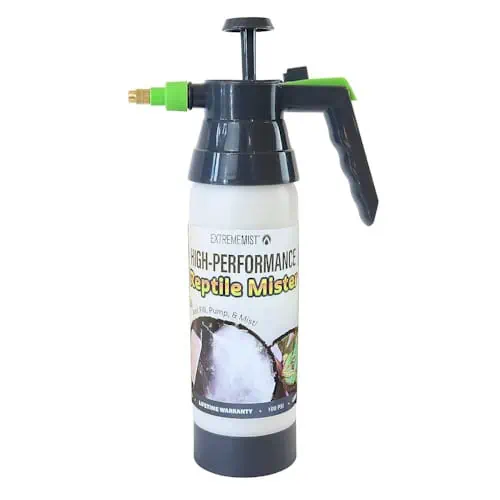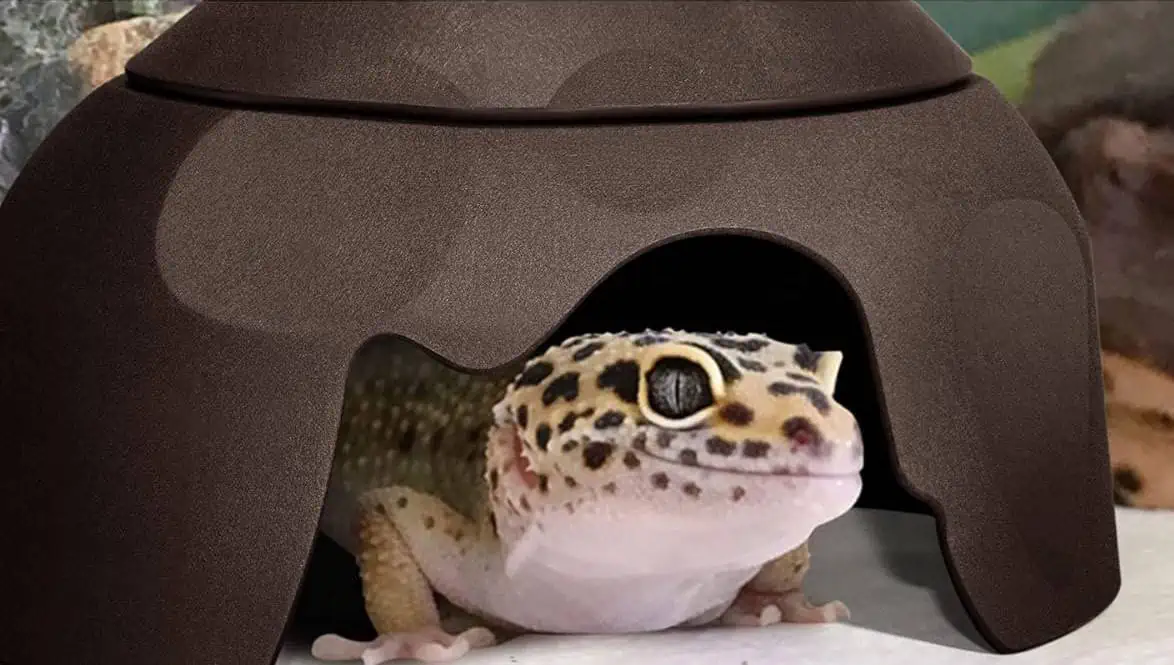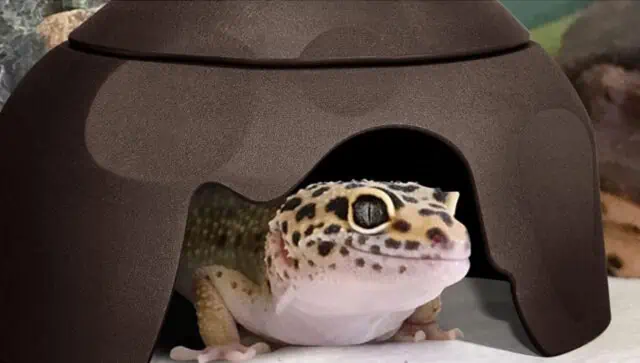Contrary to what some might think, leopard geckos typically do not enjoy being sprayed or misted with water, a technique known as misting. Leopard geckos hail from arid environments and are well-adapted to lower humidity levels, making misting generally unnecessary. In fact, if humidity levels in their enclosure are optimal, misting is not required.
If you find it necessary to adjust humidity levels, a gentle misting once or twice a week is more than sufficient, using a fine, soft mister to avoid causing stress or discomfort to your gecko.
Misting Frequency: While leopard geckos don’t require frequent misting, doing so once or twice a week can be beneficial if humidity levels drop. Monitor their shedding needs to adjust frequency.
Safe Water Types: Always use filtered or bottled water for misting. Avoid distilled or chemically treated water as they can harm your gecko.
Risks of Over-spraying: Overdoing the misting can cause mold growth in the habitat and stress to the gecko, leading to behaviors like glass surfing and burrowing.
Automated vs. Manual M
Do Leopard Geckos Like To Be Sprayed With Water? (Misting)
Leopard geckos, due to their natural habitat in arid regions, typically do not favor the practice of being sprayed or misted with water. These creatures are well-adapted to environments with lower humidity, making the common method of misting largely superfluous. When considering providing moisture to leopard geckos, it is crucial to understand their inherent needs and preferences to avoid causing them unnecessary stress or discomfort.
Is Spraying Water an Acceptable Way to Provide Moisture to Leopard Geckos?

Spraying water, or misting, can be utilized as a method to provide moisture to leopard geckos, but it is not typically their preferred way to receive it. Considering their natural habitat, they are more inclined towards lower humidity environments. Therefore, misting, while acceptable, must be approached with caution to avoid any stress or discomfort to the gecko.
When assessing the benefits and risks of misting, it’s clear that while it can help in maintaining adequate moisture levels within the enclosure, overuse can lead to potential issues such as stress and over-hydration. It’s crucial to balance moisture levels optimally to avoid creating an uncomfortable environment for the leopard gecko. If executed properly, misting can be an acceptable way to provide moisture, but understanding the inherent risks is crucial.
As for alternative methods of providing moisture, humid hides and fresh, clean water in a bowl are more favorable options. Humid hides are areas within the enclosure where humidity is higher, allowing the gecko a choice to expose itself to increased moisture when it feels the need. Offering fresh, clean water in a bowl not only serves as a drinking source but also aids in maintaining the enclosure’s overall humidity levels.
| Alternative Methods to Provide Moisture | Benefits |
|---|---|
| Humid Hides | Provides a localized high-humidity environment allowing choice for exposure. |
| Fresh, Clean Water in a Bowl | Serves as a drinking source and aids in maintaining overall humidity levels in the enclosure. |
Misting Leopard Geckos: How Often Should You Spray Water?
Misting leopard geckos should be a cautious and considered process, keeping in mind their individual moisture requirements and shedding needs. Generally, if deemed necessary, misting once or twice a week is sufficient. The frequency can be slightly increased during their shedding period to ease the process, but constant attention to their behavior and enclosure condition is crucial.
Over-spraying or misting too frequently poses several risks. It can lead to increased stress in leopard geckos, causing behaviors like glass surfing and burrowing. Additionally, over-spraying creates a suitable environment for mold and bacteria growth, compromising the cleanliness and safety of the enclosure.
When misting is performed, the water used must be safe and clean. Filtered or bottled water is usually the most suitable option, as these are free from most harmful chemicals found in tap water. However, caution should be taken against using distilled or chemically treated water. Distilled water lacks the minerals found in natural water sources, and chemically treated water can contain substances harmful to leopard geckos.
| Spraying Frequency | Impact on Leopard Geckos |
|---|---|
| Over-spraying | Can lead to stress, glass surfing, and burrowing behaviors. Creates a conducive environment for mold and bacteria growth. |
| Use of Unsafe Water Types | The use of distilled or chemically treated water can harm leopard geckos due to lack of minerals or presence of harmful chemicals. |
What Are the Benefits of Spraying Water on a Leopard Gecko?
Misting or spraying water on a leopard gecko does come with several benefits, especially when it’s done in moderation and with the right technique. One of the prime advantages is it aids in skin hydration. A hydrated skin is crucial for leopard geckos, particularly during the shedding phase, ensuring a smooth and hassle-free shedding process. Proper hydration helps in preventing shedding problems, allowing geckos to grow and develop in a healthy manner.
Maintaining appropriate humidity levels through misting is also beneficial. It helps in creating an environment that mimics their natural habitat, making them feel more at home and less stressed. Maintaining the right humidity level is crucial to avoid respiratory issues and skin diseases in leopard geckos, ensuring their well-being and longevity.
Misting is also introduced as a concept for providing moisture to leopard geckos. It’s an alternative way to ensure they receive the required moisture, alongside providing fresh water and maintaining a humid hide within their enclosure.
| Benefit | Impact on Leopard Geckos |
|---|---|
| Skin Hydration | Assists in smooth shedding and prevents related issues. Enhances overall skin health. |
| Humidity Maintenance | Creates a suitable and natural environment, reducing stress and preventing respiratory and skin conditions. |
| Moisture Provision | Acts as an additional source of moisture, complementing water bowls and humid hides. |
What Are the Potential Risks of Spraying Water on a Leopard Gecko?
Spraying water on leopard geckos, while advantageous in several aspects, also comes with its own set of potential risks. One such risk is the induction of stress and agitation in geckos. Some leopard geckos might not react well to being sprayed with water, leading to behaviors such as hiding or even showing signs of aggression. It’s crucial to observe each individual gecko’s reaction and adjust the misting routine accordingly to avoid any negative impacts on their mental well-being.
Another significant risk associated with spraying is over-spraying. Over-spraying can create excessively humid conditions within the enclosure, leading to the growth of mold and bacteria. These unwanted growths can pose serious health risks to leopard geckos, causing respiratory and skin infections. It is paramount to maintain a balanced humidity level to cultivate a healthy living environment for them.
| Potential Risk | Impact on Leopard Geckos |
|---|---|
| Stress and Aggression | Can lead to behavioral changes such as hiding or aggression, impacting the mental well-being of the gecko. |
| Over-spraying | Results in mold and bacteria growth in the enclosure, leading to potential respiratory and skin infections. |
Misting Leopard Geckos – How To Do It
Misting leopard geckos can be beneficial but it must be done correctly to avoid any adverse effects.
Manual Misting
Manual misting is one of the simplest and most cost-effective methods to provide moisture to leopard geckos. To manually mist the habitat, use an inexpensive spray bottle filled with room-temperature water. This simple tool allows for controlled and gentle misting, offering adequate moisture to the gecko without overwhelming them or making the environment excessively wet.
When misting, always observe your leopard gecko’s behavior. If they seem agitated or upset, consider misting around the gecko or at the other end of the tank, away from them. This prevents unnecessary stress and allows them to experience the benefits of increased humidity without discomfort.
Here are some tips for effective manual misting:
Use a Fine Mist Setting: Ensure that the spray bottle is set to emit a fine mist to avoid disturbing the substrate and your gecko.
Observe Behavior: Regularly observe your gecko’s reaction to misting and adjust the frequency and amount of water based on their preferences and needs.
Monitor Humidity Levels: Keeping an eye on the habitat’s humidity levels is crucial. Regularly check to ensure it is within the recommended range for leopard geckos, adjusting misting accordingly.
Automated Misting
Automated misting systems are another method used to maintain the appropriate humidity levels within a leopard gecko’s habitat. These systems offer convenience and consistency in providing the necessary moisture to the enclosure, mitigating the risk of forgetfulness to manually mist the habitat. This ensures a stable environment, which is crucial for the well-being and health of leopard geckos.
An automated misting system operates on a set schedule, releasing a fine mist into the habitat at predetermined intervals. This aids in maintaining consistent humidity levels and reduces the risks of health issues related to inadequate moisture, such as shedding problems and dehydration.
Such systems can be particularly helpful for busy gecko owners who might not always remember to mist manually, ensuring that the leopard gecko’s needs are met, even during the owner’s absence.
By employing an automated misting system, owners can prevent potential health issues arising from a lack of moisture and contribute to optimal leopard gecko care. Ensuring that your leopard gecko has access to the necessary moisture and consistent humidity levels can make a significant difference in their overall well-being and happiness.
Here are some benefits of using an automated misting system:
Convenience: Automated systems relieve the owner from the daily task of manual misting, offering more freedom and flexibility in their schedule.
Consistency: By maintaining consistent humidity levels, automated misting helps in preventing various health issues related to improper humidity.
Peace of Mind: Knowing that the gecko’s habitat will receive the necessary moisture even in the owner’s absence can provide a sense of reassurance.
Using Purified Water
When misting leopard geckos, it is crucial to use purified water as both tap and bottled water can contain chemicals that may be harmful to their health. Utilizing purified water ensures the safety and well-being of the gecko, preventing any potential adverse reactions that can arise from exposure to impurities and contaminants present in untreated water.
Various purification methods exist, including deionization, distillation, and reverse osmosis, each removing impurities and undesired substances from the water. It is generally recommended to use demineralized water for misting leopard geckos as it is free from minerals and salts which can be detrimental to the health of your pet.
Using purified water not only shields the leopard geckos from harmful chemicals found in tap or bottled water but also aids in maintaining a clean and healthy habitat. This extra step ensures that the water sprayed within the enclosure is as safe and clean as possible, eliminating the risks of introducing unwanted elements into their environment.
Here are key considerations for using purified water:
Health Safety: Purified water eliminates harmful chemicals that could endanger the health of leopard geckos.
Environment Cleanliness: Using purified water aids in maintaining a cleaner and more sterile habitat for the geckos.
Quality of Life: The absence of harmful chemicals and contaminants in the water contributes to the overall well-being and quality of life of the leopard geckos.
Alternatives to Spraying Water
While misting is a viable method to maintain humidity for some reptiles, it’s not the only solution, and alternatives can often be more suitable for Leopard Geckos.
In cases where misting may cause stress, or if the gecko shows aversion to it, understanding and utilizing alternative methods to provide moisture and maintain humidity levels within the enclosure become paramount.
These alternative methods can often be just as effective in ensuring the well-being and comfort of leopard geckos, providing essential hydration without unnecessary stress.
Using Humid Hides for Moisture Retention in the Environment
Providing a suitable and stable environment for Leopard Geckos involves the implementation of humid hides to retain necessary moisture. Humid hides are specialized, enclosed areas within the gecko’s habitat, constructed to maintain a localized humid microclimate, essential for the well-being of the gecko.
These hides are typically filled with damp substrate, such as moss, which retains moisture and creates an optimal humidity level within the hide.
When set up correctly, humid hides play a crucial role in the leopard gecko’s environment, offering them a refuge where they can properly shed their skin and stay hydrated.
Providing Fresh, Clean Tap or Bottled Water in a Bowl or Dish
Provision of fresh, clean water is crucial for leopard geckos, and it is generally achieved by placing tap or bottled water in a bowl or dish within their enclosure. This method not only ensures that geckos have access to drinking water but also contributes to the overall humidity levels inside the enclosure.
While the use of tap or bottled water is common, purified water is highly recommended to prevent exposure to potential contaminants and ensure the safety and health of the geckos.
The size and placement of the water dish can substantially influence the humidity levels in the enclosure. A larger dish or a dish placed near a heat source can elevate humidity levels, impacting the microclimate within the enclosure.
Regular monitoring of these humidity levels is vital, with the use of a quality digital hygrometer being advisable to maintain accurate readings and optimal conditions.
Utilizing Lukewarm Bathing Sessions for Adult Geckos
Lukewarm bathing sessions are another method to provide moisture to adult geckos and assist in their overall well-being. They are not only beneficial for maintaining hydration but also support the shedding process and can help in the removal of any residual shed skin. When conducting lukewarm bathing sessions, it’s crucial to follow the proper process to ensure the safety and comfort of the leopard gecko.
To set up a bathing session, prepare a shallow container with water, ensuring the water level is not too high—generally, no deeper than the gecko’s knee height is recommended.
The recommended water temperature range is between 82 and 88 degrees Fahrenheit, resembling the warmer end of their natural habitat’s temperature range. Monitoring the water temperature throughout the session is crucial to avoid any stress or discomfort to the gecko.
The benefits of such bathing sessions are multifold, aiding in hydration, easing the shedding process, and offering a gentle means to clean the gecko.
Ensuring Proper Humidity Levels in Natural Habitat Replicas
Establishing proper humidity levels within natural habitat replicas is imperative for the health of leopard geckos, and failure to maintain such balance can be detrimental. Incorrect humidity levels, especially high humidity, can pave the way for numerous health issues such as respiratory diseases, eye infections, and unfavorable skin conditions, compromising the overall well-being of the gecko.
High humidity within the enclosure is detrimental, leading to a conducive environment for bacterial and fungal growth, which can, in turn, affect the leopard gecko’s health. This necessitates well-ventilated tanks to prevent the build-up of excessive moisture and to maintain a balanced and healthy environment.
Well-designed ventilation systems are crucial, allowing fresh air to circulate and stale, moist air to exit, hence reducing the risks associated with high humidity.
Additionally, it’s vital to address the humidity issues caused by reptile waste. Improving ventilation can significantly mitigate the risks posed by accumulated waste.






